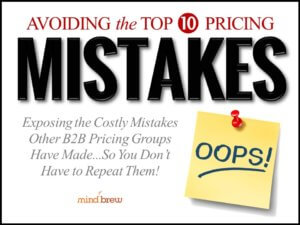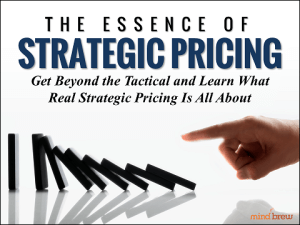Over the years, I’ve noticed that some pricing groups will actually choose to remain tactically focused, rather than transition into more strategic functions. To be clear, it’s not that they’ve tried to become more strategic and were largely unsuccessful. No, these teams have made a conscious decision to not even try.
Why? Very often, it’s because they’ve assessed the risks…incorrectly.
On the one hand, they’ve concluded that there’s a certain amount of safety and security in the tactical stuff. After all, the tactical stuff is likely what others in their organizations currently expect from them. The tactical stuff is also pretty obvious, tangible, and immediate. So, as tedious and frustrating as the daily firefights and grunt work may be, the status quo is a known quantity. And over time, it can even become somewhat comfortable.
On the other hand, these teams tend to believe that the strategic stuff is “edgy” and extremely risky. In many cases, the strategic aspects of pricing will be completely new to everyone in the organization, including members of the pricing team itself. The strategic issues are also often harder to recognize and the benefits can take longer to manifest. And the strategic stuff will necessarily require teams to step outside the perceived boundaries of the pricing function.
While many of their underlying assumptions and characterizations are pretty accurate, the conclusions these teams have drawn from them are dead wrong. In fact, they have it completely backwards. A pricing function that chooses to “stay in their box” and focus solely on the tactical is not taking the safe and secure route at all. Instead, they are actually magnifying their risks in three big ways:
- Competitive Risks—In any competitive environment, standing still is falling behind. So when the strategic aspects of pricing go unaddressed, there’s an ever-increasing risk that competitors will move ahead, figure out how to win more business at higher profits, and gain insurmountable advantages in the marketplace. And no one wins when the company that employs them is losing in the marketplace.
- Functional Risks—Tactical pricing improvements simply do not have the leverage or power to produce significant financial gains. And in most B2B environments, where pricing can be a somewhat contentious thing to begin with, not being able to point to solid financial impacts and contributions can actually put the entire pricing function at risk.
- Personal Risks—While upper management may not be pushing the pricing function to focus on anything beyond the tactical right now, that can all change overnight. When management determines that there are bigger pricing issues that aren’t currently being addressed, it tends to reflect poorly on the existing pricing function. And as a result, people in the existing pricing function will often find themselves being pushed aside in favor of “new blood” with “more strategic perspectives.”
When you have an incomplete or inaccurate view of the risks involved, it’s very easy to draw the wrong conclusions. And when you haven’t done something before, it’s easy to overestimate just how challenging or risky that new thing will actually be.
So…first recognize that the tactical side of pricing is not the “safe haven” it may appear to be, as there are significant risks lurking right under the surface. Then, learn all you can about the strategic side of pricing and how other groups have managed to make the tactical-to-strategic transition.
And once you see that it’s not nearly as risky or difficult as you might have imagined, I’m confident you’ll make the right decision about the direction of your pricing team.
















